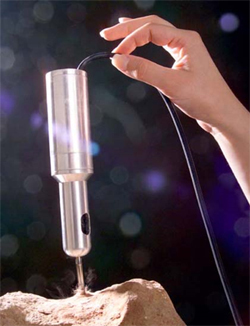
Dr. Yoseph Bar-Cohen, supervisor of the Advanced Technologies Group and a senior research scientist, is the coeditor and coauthor of a book released in July 2009 titled “Drilling in Extreme Environments – Penetration and Sampling on Earth and Other Planets” that he hopes will be able to help solve current drilling woes. The book, Bar-Cohen’s sixth, goes into detail about the current capabilities for drilling on ground, through ice, under water and – perhaps most impressively and extensively — on other planets. Not only does the book cover how to perform the actual drilling, but also how to sample and analyze the samples as well as how to prevent contamination that can risk our planet and other bodies in the universe. Apollo 17 astronaut Harrison Schmitt, the first geologist to ever drill on the moon, coauthored the foreword.
“We’re finding out that drilling is much more difficult than we imagined,” said Bar-Cohen, which is why what started off as a 70-page special paper for the Journal of Astrobiology quickly turned into an 825-page book. The complexities of drilling on other planets stems from the need to be ready for all types of surfaces – extremely hard, extremely soft, and anywhere in between. One drill has to have the capacity to do everything – start the hole, rotate and hammer, and then grab the sample out of the ground for analysis. The drill also needs to be as lightweight as possible.
Bar-Cohen hopes the book, which contains many contributions from fellow JPL colleagues, will help scientists have a firm understanding of the current drilling technology so that they can advance techniques for future NASA missions, such as Constellation. The book suggests sites for testing drills on Earth that are as geologically similar to the moon and Mars as possible. It also lists environmental chambers where extreme conditions found on the moon and Mars can be simulated.
Bar-Cohen also tied in ideas from his third book, “Biomimetics – Biologically Inspired Technologies,” stating that drilling is incredibly natural if you consider things like woodpeckers, termites and tree roots. “Nature has its own contributions to drilling that I think we need to learn from,” he said.
At the same time he was working on this most recent book, Bar-Cohen was coauthor of “The Coming Robot Revolution – Expectations and Fears about Emerging Intelligent, Humanlike Machines,” which details the advances in smart robot technology. Bar-Cohen believes the development of humanlike robots is imminent and important because of their capabilities to help the elderly and disabled, as well as to replace humans in life-threatening activities like space exploration.
“We build our world around ourselves – our shape, our size, our capabilities. This means that robots need to be like us in order to take over these tasks and communicate with us,” he said. So far, robots exist that can – among other things -- recognize up to 1,000 words, pick up an M&M with a prosthetic hand, and distinguish positive versus negative voice inflection.
References
- JPL NDEAA Group
- Boring the Planets (Feature Story on the Gopher device)
Story by Alex Abels Republished with permission from Daily Planet, JPL’s intranet news website.